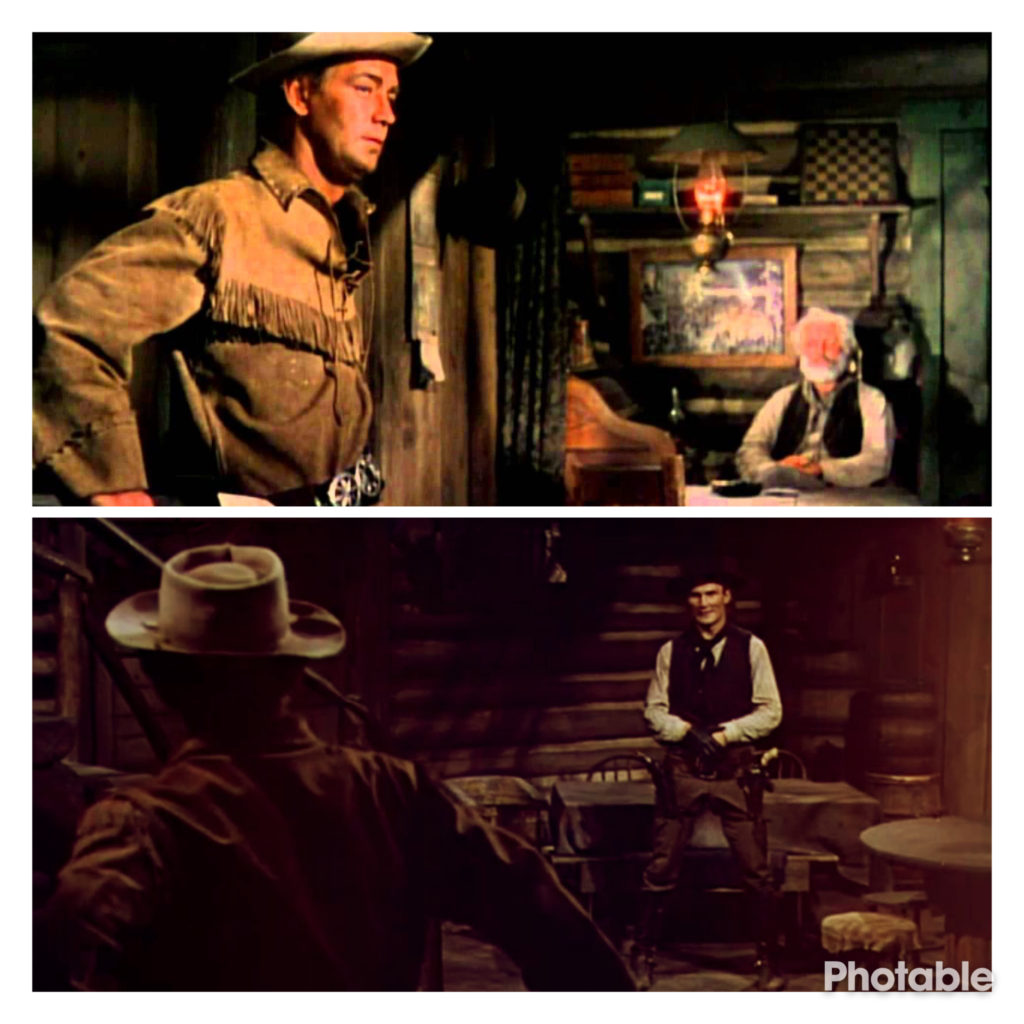1953. 118 Minutes. Not Rated.
Quote: There’s no living with a killing
I first found this picture when I was working on my undergraduate degree in Lowell at the University of Massachusetts. I was in a Philosophy of Film class taught by the great Whitley Kaufman It was one of the best courses I ever took, taught by the best teacher I ever had. Kaufman taught me that there is a lot more going on in films than the casual viewer might notice. I always loved film, but he taught me how much I could learn about life through movies, and in truth, The Big Brown Chair doesn’t exist without Whit and that first influence, so here’s to you sir. The film that stands out most from the class… 1953’s Shane.
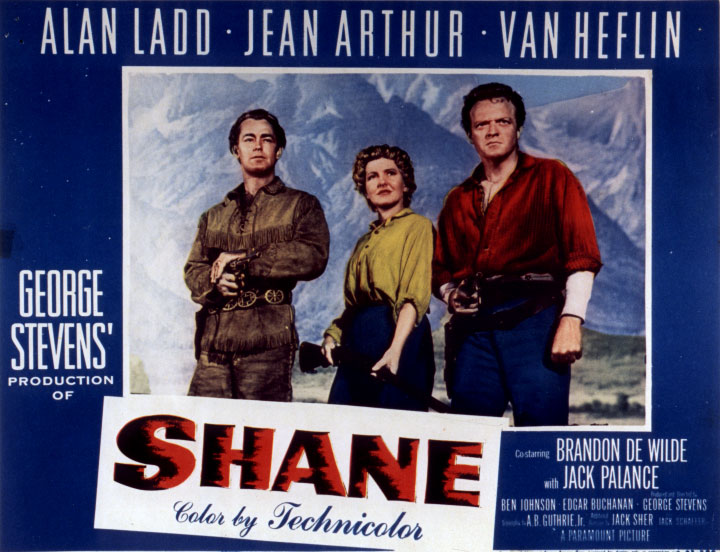
Shane – Paramount Pictures
Shane (Alan Ladd) is an outlaw gunslinger trying to change his ways. We’ve seen many films like this about a former outlaw, who wants to give up his rough life and settle down. A few that come to mind are Star Wars (Obi Wan Kenobi) Unforgiven (William Munney) John Wick (John Wick) and fairly recently, Hugh Jackman as Logan in James Mangold’s Wolverine swan song, Logan. Shane was quite possibly the first, and set the bar high for all that would follow. They’ve been following for over 65 years.
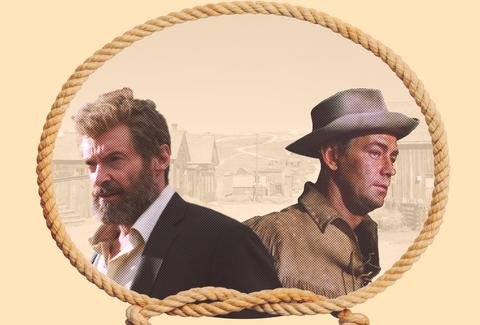
The movie begins when Shane and his horse stumble onto The Starrett homestead. He observes that he “didn’t expect to find any fences around here” really setting the movie up for us. Shane finds a family of pioneers living in this Wyoming valley: Joe Starrett (Van Helflin), his wife Mariane (Jean Arthur), and their son Joey (Brandon De Wilde). Shane meets them, has some cool water, a little conversation, and quickly aids father Joe in warding off a gang of toughs led by Rufus Ryker (Emile Meyer). With that, the stage is set. Ryker and his gang want the valley for their own, to raise beef, and pile money sky high. Starrett and several other families spread across the valley have set up homes to begin creating a life. They want to raise crops, livestock, and hell, to raise their families. Ryker wants them gone and throughout the film he takes measures to bully them and scare them out.
Shane finds warmth among the Starretts and stays on as a hired hand to help with the work, and find himself a piece of the good life. Throughout this story Shane reflects on what could be. He admires Joe as the strong family man, and head of the house type. He’s attracted to Marianne too, and the idea of having a wife like her. He’s especially taken with the young boy Joey, who idolizes him, as children do. Shane never had a life like this, he never wanted it, and he never got it. When he literally stumbles upon it though, something happens… he gets a glimpse, and he likes it.
Shane finds a group of families being run off their land. They want to stand up to the threats, but they don’t have the means, the abilities, or the courage.
What they need is Shane, not the man who’s been working to become one of them, but the man who found them by accident in the first place. He’s not just a gun slinger though, Shane has many layers.
The List: The Layers to Shane
- Shane wishes he was Joe
As mentioned a minute ago, Shane is attracted to Joe’s life. He sees what could have been, and really appreciates it for the first time in all his life. He sees why a man like Joe has dedicated himself to these passions: home, family, safety, security. Joe wouldn’t have made a good accountant — he’s the type of man who needs to build, needs to create; he wants to grit his teeth, work hard, and have something to look at after a job well done. He’s the type of man who Shane can admire. He goes through different stages of admiration throughout the film, and it’s real interesting to watch. He first seems to want to be Joe himself, then he grows into wanting what Joe has, and eventually (if only for a minute) he realizes how it easy it would be to just take it, to take this boy, this woman, take this farm. He could do it too. The boy worships him instantly, Joe realizes this man could be his replacement if he were to be killed by Ryker’s gang, and Mariane looks at him with a glow that surprises even herself. Shane could just take it all. He doesn’t though.
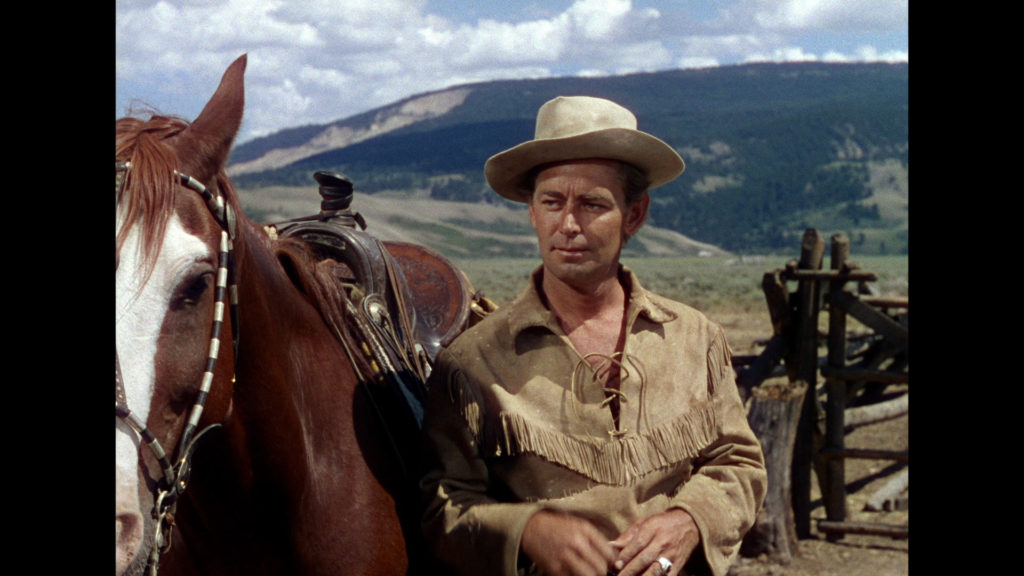
Shane – Paramount Pictures
We see some fun male bonding too, between Shane and Joe in a few spots. First with the removal of a tree stump, next when Shane is standing up to Rykers gang at the local saloon. As the homesteaders look on and see Shane fighting off seven men at once, Joe takes off his jacket, picks up a club, and jumps in to join the fight alongside Shane. Through these scenes we see Joe accept Shane into his family, and into his life, naive to the fact that while Shane means well, he would be a big threat to the Starrett way of life if he wanted to be.
2. Shane wishes that he’d done things differently
When Shane rolls into the farm he begins to shed his persona fairly quickly. Before long he’s aligned himself with Joe to stand up to Ryker, while he’s probably got more in common with Ryker than Joe. Next he starts the hard work on the farm to try this life on for size, he’s hung up his 6 shooter, and trades his battle garb for some farming work clothes. Shane is looking for an escape and he’s found it. This could be the new life he never knew he wanted, he could reinvent himself here, he could be just another guy. It’s attractive to any man even a century later. Find a piece of land, build a house, make your wife happy, raise a little boy.
Going back to the gun and the clothes for a second, that’s a really big statement in the film, and it’s easy to overlook. He’s a cold blooded killer, never goes anywhere without his gun, and several times as we’ve mentioned here, he’s easy to startle, because he’s seen lots of action. The fact that he goes to town without his gun is huge. That’s him truly making a go of what this life could be for him. He gets challenged in town and lets the other man win, he doesn’t fight at first, because that’s not what Joe Starrett would do. He’d swallow his pride and not get into trouble, even if he looked like a wimp to the one picking the fight.
Many times while watching the film, I thought of Shane as being present in a scene, but not a part of it, like Ebenezer Scrooge being shown the past or future by a Christmas Ghost. He’d stand off to the side observing, with a quiet reverence, but inside was holding on to a spot of jealousy.
It was marvelous to lose myself in the film, and in the way things were. Some will read this and call it misogyny, but truly I don’t mean it to be. Men have been keeping women down for the majority of human history, and in my life I’ve seen women come very far, and they aren’t slowing down. They are focused on what they want, and what they know they deserve. Equal pay, truly equal rights, to conquer the business world and fight for other oppressed groups. I’ll tell you what, I was raised by a strong women, married another one, and work among mostly all women. I hope they get it all, the respect, the money, the white house… everything.
That all said, for a guy like me to think about “the good ole days” in my mind, I guess I mean the “image” of the good ole days, like what we see in Shane. I respect the fact that the vast majority of men in Wyoming in 1889 probably weren’t like Joe or Shane, and they were most likely treating women like crap. Just for a minute though, let me imagine my own fantasy life. Living off the land, before the internet, the light bulb, the library, and in a time (made up or not) where we lived under the stars, treated women and minorities with respect, had some animals, some crops, a happy hearth, the beautiful mountains and vast plains. I know my lens is that of a white guy without too many problems in Boston Massachusetts, but it’s just a nice thing I can imagine when I close my eyes.
My overdone point here, is that watching Shane, made in 1953 and set in 1889 I wish sometimes (like Shane) that I could trade places with Joe Starrett.
- Shane realizes that he is who he is, so we might as well get on with it.
Shane wants to change his life, and his stripes. That much is clear. What’s fascinating about Shane the character (and it really pops out when you re-watch) is that he can’t. It’s not possible. You can’t change what you are, and you can’t go back in time. There’s no changing a brand. There’s no turning back. He is what he is. He Shane tells us a lot about his past, while not actually telling us anything.
When he hears a horse spook, he draws his gun lighting-quick and gets low. When Ryker brings in a hired gun named Wilson (Jack Palance) Shane knows who he is just by description. There’s a man with a gun, a mean look, and a black hat. Shane knows who he is straight away. That tells us a lot. How does he know this bad bad man so intimately? Because Shane is a badder man. He may look like Ryan Gosling: dashing, with a quiet strength, but really… he’s Clint Eastwood’s man with no name; a cold blooded killer, carved out of wood.
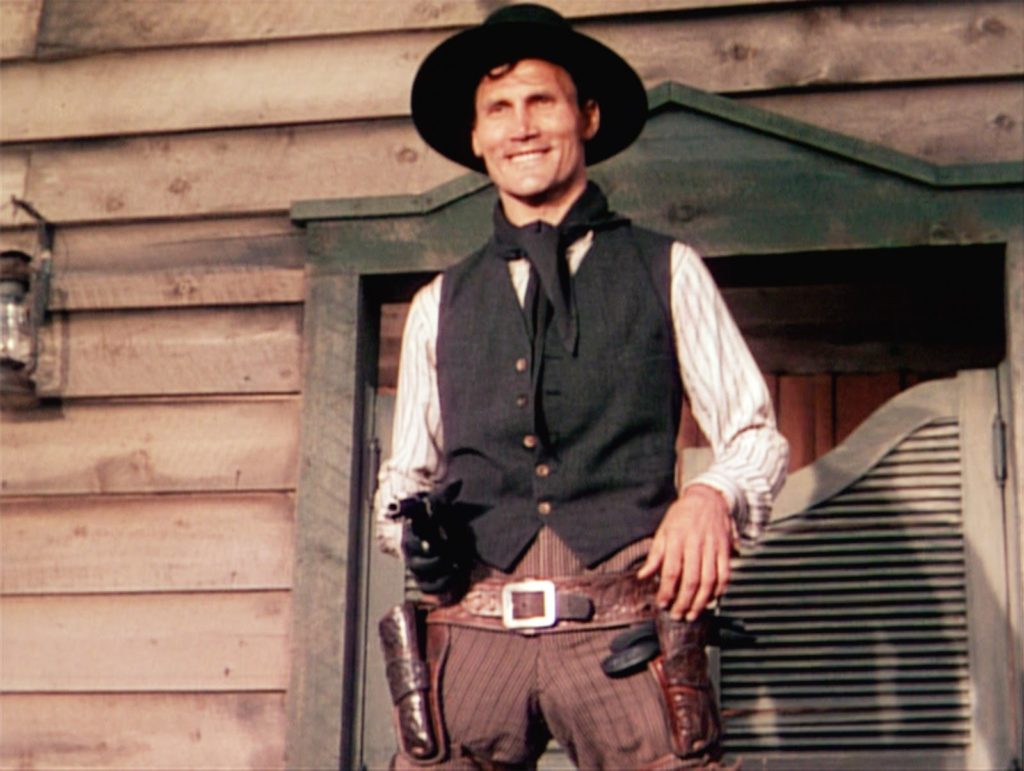
Jack Palance as Jack Wilson in Shane
Shane knows what is needed to save the family, to save the farm, to save the valley, to stand up to Wilson and Ryker, and at the end of the story, he changes back into his own clothes, straps his six shooter back up, and set out to do what needs to be done. They don’t need Joe to step out of his comfort zone, and try on the role of the bad man in the pursuit of keeping his family safe. He hasn’t got it, and he’ll die sure as the day he was born. Shane though, he’s got it. He’s what they need. He heads into town alone, to settle things once and for all.
(end of The List)
What I really love about this picture is that the story isn’t even the story. Ask anyone what Shane is about, they are mostly going to say the same thing. It’s a movie about bad guys trying to bully around good guys. It’s a story about a gang of toughs trying to run the homesteaders off and take over their land. That’s not what it’s about. A favorite scene of mine lays out the real story pretty nicely: Ryker shows up at Joe’s farm one last time with his hired hand, Wilson. Ryker wants to come to an agreement with Joe, but move the rest of the homesteaders out. Ryker and Joe go back and forth in conversation, jockeying for position. In the background, Shane watches silently. The dialog tells one story, the story of a negotiation between Joe and Ryker. The picture tells a different one: Shane and Wilson, Night and Day, Darkness and Light. The two cowboys smile, size each other up, and never say a word. This story really isn’t about the gang versus the homesteaders, it’s a story about the killers, about Shane and Wilson.
If you feel like burning five quick minutes, here’s the scene, it’s just great:
Rocky isn’t about boxing, and Shane isn’t about Ryker trying to muscle Joe Starrett off his farm. Shane IS ABOUT SHANE!!! Shane would like to be this, and wished he could be that…. he can’t though. Shane can’t change his stripes. He’s a killer, and there’s no living with a killing. John Wick can’t let it go, William Munney can’t be a pig farmer, and Logan can’t ride off into the sunset. They know what they are, and so does Shane… so let’s get on with it.
